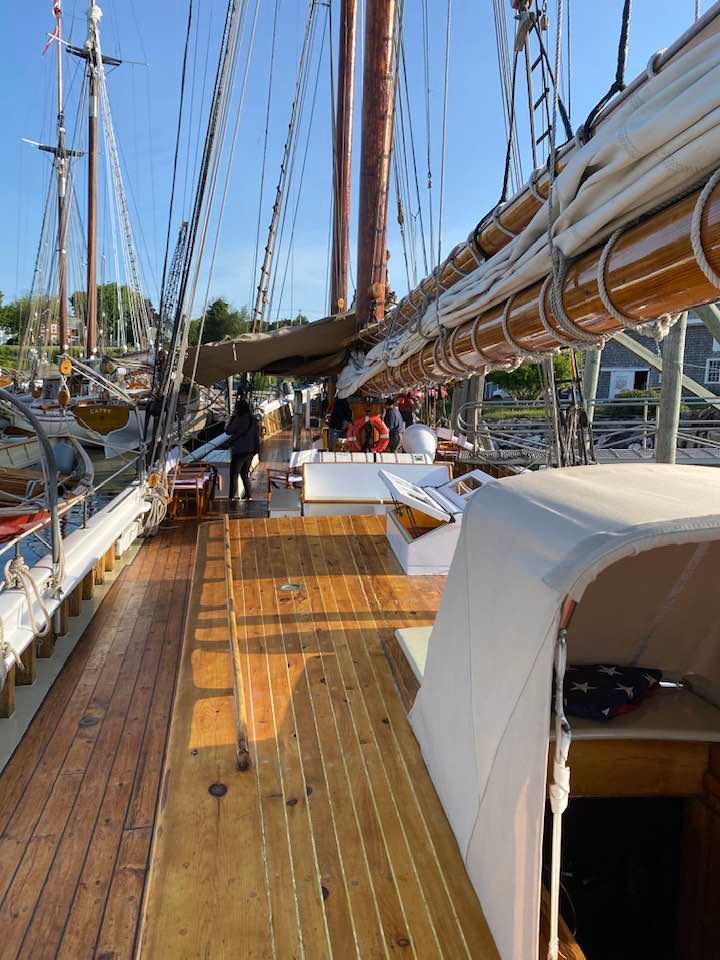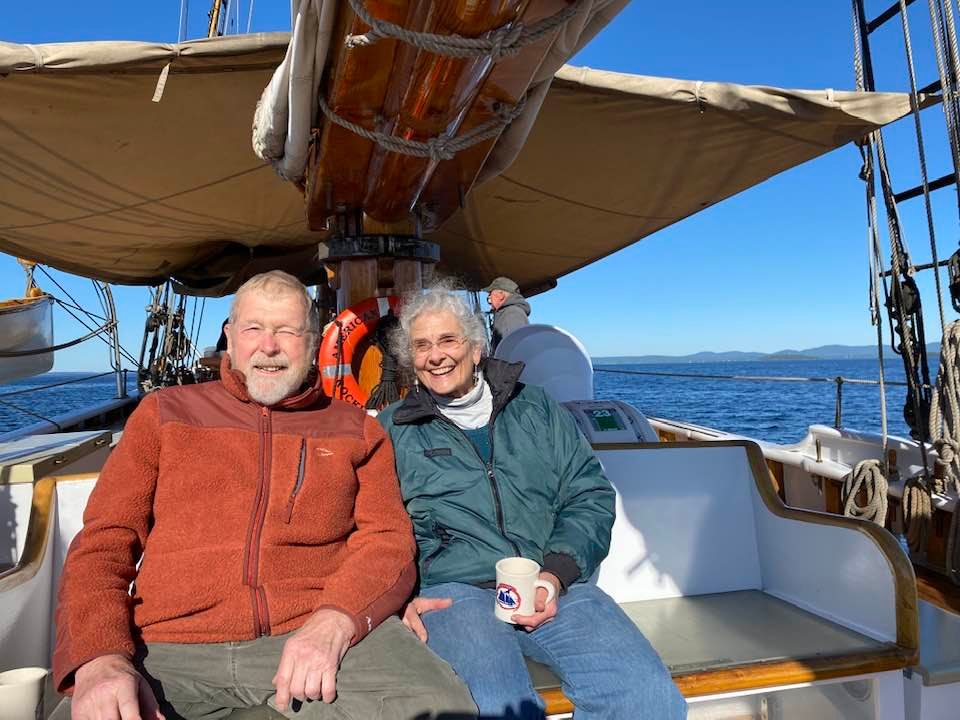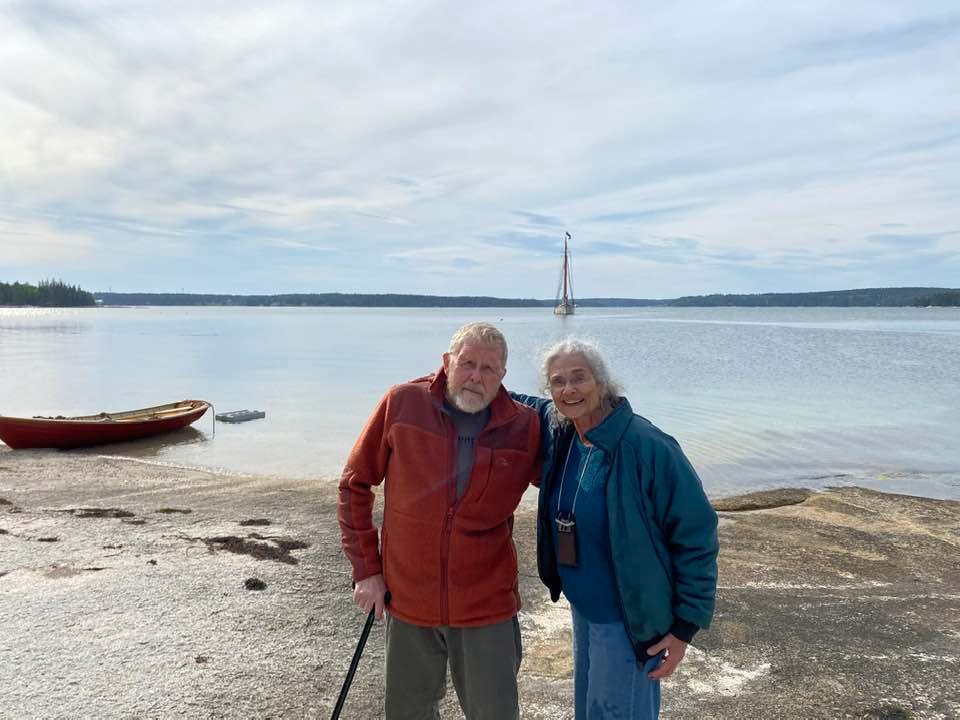A Yankee Notebook
NUMBER 2135
June 20, 2022
A Return to Hurricane
EAST MONTPELIER, VT – On a perfect bluebird day (recognizing that at sea almost nothing is ever perfect; we were a little light on wind) the schooner American Eagle sailed southward through the Fox Island Thoroughfare and Leadbetter Narrows and into Hurricane Sound. She anchored about a hundred yards off the main pier of the now almost abandoned island and lowered her seine boat over the side. A devout wish of mine was about to be realized: We were going ashore.
Tourists, as perceptive as some of us may think ourselves, usually miss many of the nuances of the scenes and situations they see. I’m still not entirely sure whether our stop was to give our on-board historian a chance to show us a once-thriving, but now vanished island life, or the fact that the captain’s girlfriend, who works there, would be leaving with us when we departed. But as Bruno Bettelheim once noted, the motive is nothing compared to the fact. And the fact was that I’d again be walking old trails that my family and I had haunted almost sixty years ago.
The physical remains of Outward Bound are still everywhere - the cavernous dining hall/office suite and boathouse/storerooms. But the dozens of students and instructors teeming the trails, swimming area, ropes course, waterfront, and cliffs are absent. The cost and logistical challenges of operating an island base long ago became onerous, so it was moved to the mainland. That was the third time the island had been abandoned.
Native Americans once frequented these islands in Penobscot Bay, but left almost no trace of their activity except for an occasional midden of shells from their seaside picnics. Few explorers landed on their thickly overgrown shores. Over time, as European fishermen found them attractive, they incorporated them into towns and made them private property. Hurricane Island - there are a few probably apocryphal theories about the origin of its name - was known to mariners as a source of fresh water. There’s even a spring on one hillside, now almost unknown.
Then came the post-Civil War boom in municipal construction. Clear, imperfection-free granite became a desired building material; and Hurricane and several nearby islands were composed of it. Enter, in 1870, one General Davis Tillson, USA (ret.), who had distinguished himself in the Civil War as an engineer and artillerist, in spite of missing most of one foot. A staunch conservative and workaholic, he purchased the island and opened a quarrying and shipping operation that lasted, in spite of labor problems (many of the workers were Italian anarchists) and Tillson’s exploitative management style until a November day in 1914, when the operation closed suddenly and the workers and their families were evacuated forcibly just one day later.
Outward Bound discovered the abandoned island about 1960, negotiated a lease with its then-owner, and began running sea-based courses in the summer of 1965. Crews from nearby Vinalhaven, augmented by volunteer labor, put up the huge, all-but-abandoned buildings that still stand, used by the current program operating there, the Hurricane Island Center for Science and Leadership. Students coming to the island are exposed to a combination of scientific investigation of marine ecology and some of the team-building and initiative tests of the old Outward Bound.
We climbed the ramp to the main pier. My first peek was into the old mess hall, where a young man, surrounded by cavernousness, worked on a laptop. I looked for vestiges of Nansen Watch’s life at a table near the big front windows, and found none. Then we walked along a dirt road, still in my days here coated in now-gone coal dust, gaped at a huge boiler, piston, and flywheel, and ended at the quarry pond, where once we learned Drownproofing and screwed up our courage for the dreaded 50-yard underwater swim. Above us rose the walls of the abandoned quarry, the scene of rock-climbing classes. The spruces below are reclaiming their turf, even among the boulders.
On the way back to the pier, I turned onto a little-used path past a magnificent elm (no disease here yet) toward the cabin where my family and I spent several summers growing up. The ship captain, curious or concerned, I suppose, came with me. There it was, looking good, clad in the cedar shingles I nailed on myself so long ago. I returned, smiling quietly, to the waiting ship.

Day one: All aboard and ready for breakfast.

Sailing into Hurricane Sound

Ashore

